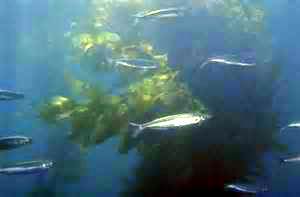The fishery opened near Craig and Klawock on western Prince of Wales Island on March 17. Fishermen catch herring and deposit them into floating net pounds. Herring lay their eggs on kelp blades suspended in the pounds and are released after spawning. It’s the herring roe that is sold to Asian markets.
Scott Walker is the Alaska Department of Fish and Game’s area management biologist in Ketchikan.
“We had fish available for everyone that was there and looking for fish and they all seemed pretty good size and that sort of thing. We won’t know really the outcome of how much product was landed and how all of that came out until more of it has been sold. But in our estimation it was a pretty successful fishery this year,” Walker said.
Some 137 permit holders participated in the fishery and used 47 herring pound structures, with a number of permit holders sharing those structures. The department mapped about 12 point three nautical miles of herring spawn in the area during aerial surveys.
Walker says the start of the herring spawning was a little earlier than usual.
“The spot spawn that we had which is pretty common to have fish jump here jump there a little bit early was about as early as we’ve seen. But then when they actually started spawning, really the main spawning event was from the March 25 through the 31st, that was a bit on the early side but nothing out of the ordinary there,” Walker said.
Historically the spawn has happened in late March through mid-April.
This was the first year for a Board of Fish approved change to the number of kelp blades allowed for permit holders. Walker thinks that change was successful in reducing the impact of the herring fishery.
“We felt that we were taking a little too much herring based on the amount of blades they were given. So this is the first year we’ve tested out this new allocation plan. And we felt that it worked pretty well. Last year without the plan we had some 75 pounds or so and this year and this year we had, what’d I say, 47. So it seems to have been fairly successful in making less structures and theoretically less fish being caught,” Walker said.
Craig-Klawock was the only herring pound fishery in the region this year. Other herring populations in Ernest Sound, Tenakee Inlet and Hoonah Sound that historically have had fisheries did not meet thresholds to hold commercial openings.










